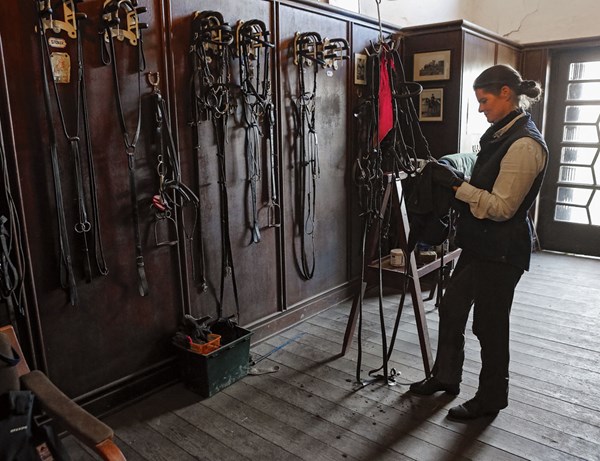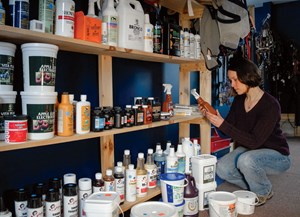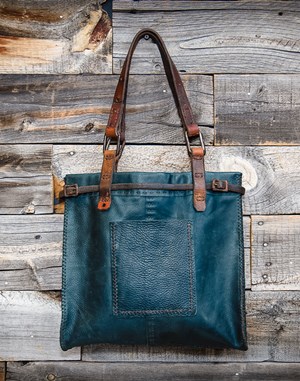
Horsepeople can be a remarkably sentimental lot. They wouldn’t think of parting with their first Breyer model (even if it is missing a leg or two), the tarnished silver bottle opener in the shape of a boot won at a long-forgotten horse show or the box of moldering Pony Club ribbons. Hanging on to old bridles and saddles is a trickier proposition. A well-maintained saddle can last a half-century or more, but leather that has started to break down poses a serious safety hazard. How should a conscientious rider proceed? Knowing how to evaluate and extend the life of your tack and what to do with your old gear once you’ve made an upgrade can go a long way to protect what, for many of us, is a major investment.
Maintaining Your Leather

Whether you’ve just put down a sizable chunk of money for a new saddle or want to keep the one you’ve got in prime working condition, taking care of your tack will save you money in the long run. But ask five people the best way to clean and condition tack, and you’ll likely get five different answers. Some are loyal to old standbys like saddle soap, while others swear by particular brands of European leather balsam. So what does leather need?
Like our own skin, animal hide is made up of about 70 percent water, and the tanning process reduces the moisture content to about 25 percent. Jochen Schleese of Schleese Saddlery says the key to healthy leather is keeping it clean and lubricated.
A certified master saddler, Schleese has been fascinated with leather since he was a boy. The German native spent his childhood in Argentina, where he met gauchos who drove cattle for six months at a time on the Pampas. “They pass their saddles on to their sons and their sons’ sons. Why do their saddles last so long? Not because they’re constantly using the latest oil or soap. It’s because they grease their saddles with goat grease every time they ride. The simplest source for animal grease on the market right now is leather balsam.”
Schleese says today’s saddles typically last at least 15 to 20 years. Starting with high-quality leather and a well-crafted tree, that can extend to a half-century or more. The biggest enemies to leather are soap, oil and sweat. “If I want to sell a lot of saddles, I tell people to use a lot of soap and leave it on. The soap acts as an acid, and the leather will burn from the inside out. You cannot make a faster disaster than that. It’s very simple. Leather is just treated skin and should be treated the same way. Use soap to clean off sweat and dirt, rinse it off, dry it and apply conditioner. Sweat will also eat away at the threads and stitching. The only thing worse is oil. If you want a saddle to fall apart quickly, use oil.”
“Sweat does massive damage to tack,” says Sherry Belton, co-founder and managing director of Albion Saddlemakers. “We can always tell when a saddle hasn’t been regularly cleaned after riding, because the leather becomes very hard and brittle and cracks. It’s a false economy for riders not to wipe the sweat off their saddle—both top and bottom—because it shortens the life of the saddle.”
At W Farms, a busy sales and training facility in Chino Hills, California, there’s always a fresh bucket of water in the grooming area so bridles can be wiped down as soon as they’re taken off the horse. “We use a damp sponge and a bit of glycerin soap and then wipe them again with a slightly damp cloth so as not to leave a residue behind,” explains manager Amanda Olson. “The saddles are wiped down at the end of the day and then put away with their covers.” For more conditioning, a light application of Effax Lederbalsam is used twice a month. Once a month, they take the bridles apart and oil them with Hydrophane Leather Dressing, then let them sit a day so it really soaks in.
Keep in mind that where you live makes a difference in how you clean your tack. Leather needs to be able to breathe, so maintaining a saddle is different in Maine than in New Mexico. “If you have a lot of moisture in the air, you don’t want to use as much water,” Schleese explains. “Maybe you just need a damp sponge. In Arizona or somewhere that’s super dry, I hose that saddle off.”
Schleese is used to startled reactions when he hoses off his tack. “I ask if they’d rather wait until the sweat soaks into the leather and dries inside.” After a light hosing, he’ll wipe the surface with a towel and rub in leather balsam while the leather is still damp. “It’s like putting cream on your face,” he says. “When it’s extremely dry, it soaks in in no time. If the skin is a little wet, it doesn’t go in as fast.”
Tack Checks and Repair

Tony Webster of Virginia Leather & Tack advises riders to inspect their tack at least once a month, paying close attention to places where the leather is showing signs of brittleness, wear or deterioration and making sure all stitching is intact. Pull firmly on and twist straps and stirrup leathers to see how they hold up; if the leather shows signs of breaking, you’re overdue for a repair or possibly a replacement. When in doubt, always take your saddle to a reputable saddler or return it to the manufacturer for repairs.
Webster learned his trade as a teenager in Walsall, England, and now repairs tack from his shop in Round Hill, Virginia, where replacing billet straps, reflocking saddles and replacing seats keep him busy. “You’ve got to look at all the major parts—where the bridle is attached to the bit, but also the stitching. Especially with older saddles, if the billets look good, we tend to forget where they’re attached.”
At W Farms, the staff rides between 35 and 40 horses every day. “Pretty much everything in our tack room goes out most days, so it gets a good looking over,” says co-owner Alisa Wilson. “If something starts to look a little frayed, our grooms and working students bring it to our attention before we have an unfortunate incident in the arena. Cleaning the bridles once a month also gives us a chance to look at everything. We’re incredibly fortunate that there’s a leather maker nearby, so we can call him if a noseband is broken or we lose a keeper.”
The W team also works closely with saddle maker Sebastian Dresch. “Since our saddles go on a lot more horses than at a typical training barn, we have them checked about four times a year,” says co-owner David Wilson. “The fitter reflocks or adjusts the saddle so that it fits properly for optimal performance,” Wilson adds.
Riders should be “tack aware,” says Belton. “It’s not just about keeping your tack looking pretty; it’s a complete safety routine, because your life is on the line. People get killed because their stirrup leathers break or their reins snap. Part of getting your saddle checked every year is to make sure the tree isn’t broken and that the rivets haven’t gone or that when you give the saddle a really good pull the springs in the waist haven’t popped and are going to come through the panel straight into your horse’s back.”
No matter how small, any accident you have with your horse should prompt a professional check. “Trees get broken; they get twisted or damaged when they get rolled on; stirrup bars become loose,” Belton points out. “If somebody that’s had a fall sends a saddle back to us, we recommend a new tree, new stirrup bars and a new headplate.”
High-quality leather tack is a serious investment. Caring for it consistently will add years to the life of your equipment and keep you and your horse safe and comfortable.
What the Riders Do
“I donate all my old equipment to the local chapter of the U.S. Pony Club. The kids either use the equipment themselves or sell it to raise money for the club.” — Adrienne Lyle
“The saddles are usually sold within the stable. We’ve also had great luck selling them on eBay. Other tack is usually donated to a local Pony Club or used tack store.” —Alisa Wilson
“Sometimes I hang on to a saddle to have it fitted to another horse or I sell it and get a new model. I’ve given one or two away to someone who has needed a better saddle too.”—Shelly Francis
“I’ve been in the same saddle brand for 10 years now, and I just repair them whenever they get too worn. I normally use my new tack for shows, and when it doesn’t look good anymore I use it for daily work at the barn. There’s not much left of my equipment once I’m done with it. But if it’s still good enough for someone to use, it gets donated.” —Mikala Munter Gundersen
“We hang on to them… pretty much until the leather is falling off!” —Shannon Peters
New Life for Old Tack

Say you’ve bought a new saddle but don’t want the old one taking up valuable space in your tack room (or attic or closet). For usable gear, tack swaps and paddock sales can be an option, as is selling a saddle on consignment at your local tack or feed store. Websites like dressagestar.com, pelham-saddlery.com and trumbullmtn.com are another avenue. Tack can also be donated to riding and veterinary schools, while horse-rescue groups, therapeutic riding centers and 4-H clubs often hold tack sales as fund-raisers.
What to do when your saddle is no longer safe for riding, but you don’t want to add to our already overcrowded landfills? Consider the creative route. (Some advise first cutting off the billets or writing “broken tree” on the gullet to make sure no one rides in it.)
In Colorado, Cigdem Aritan creates one-of-a-kind leather bags (shown left) for her company Cibado, using antique hardware and old reins found at tack swaps and shops, farm auctions or through ads she places on Craigslist. “They’re so full of character, and they smell like a barn when I bring them back to the studio. Some things that I come across are clearly too far gone and dry-rotted to use but others just need a little cleaning.”
In Wellington, New Zealand, designer Tim Wigmore turns worn saddles into Giddyup Rocking Stools for people of all ages. He even tells customers how they can put their own saddles atop his sustainable wood bases.











